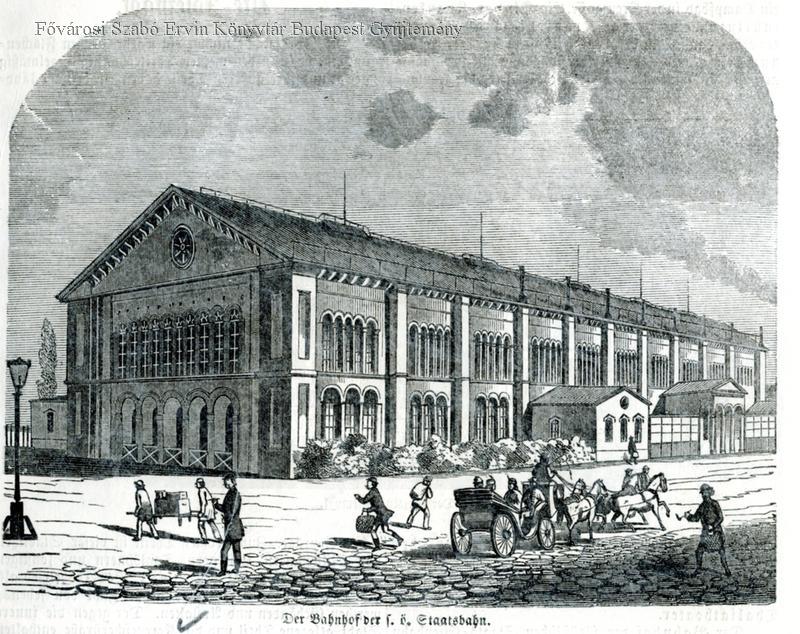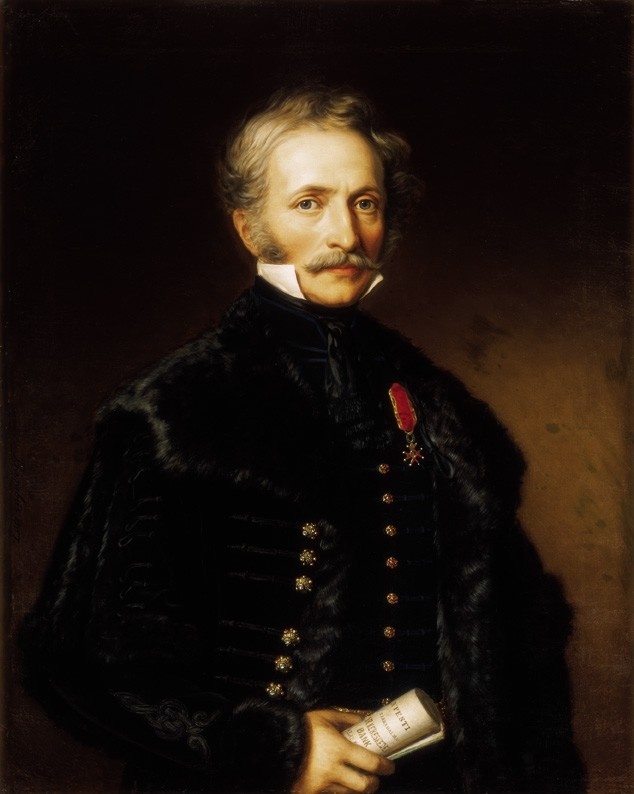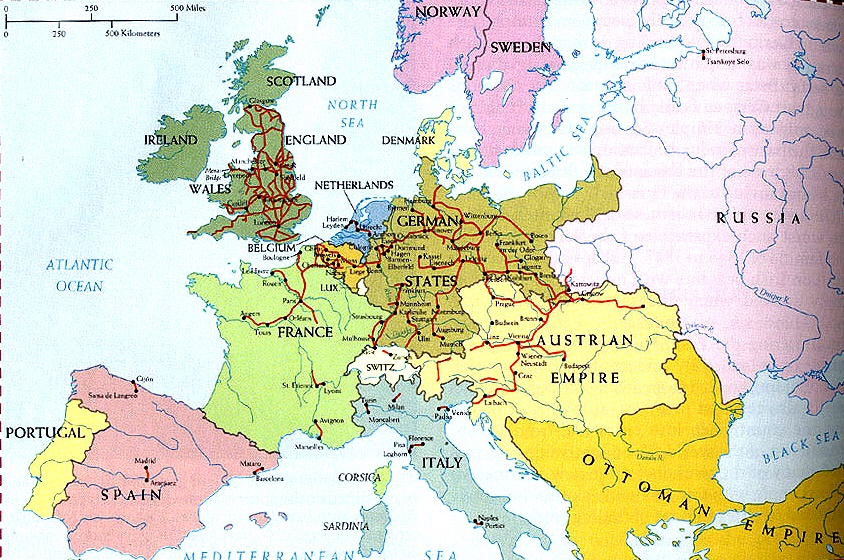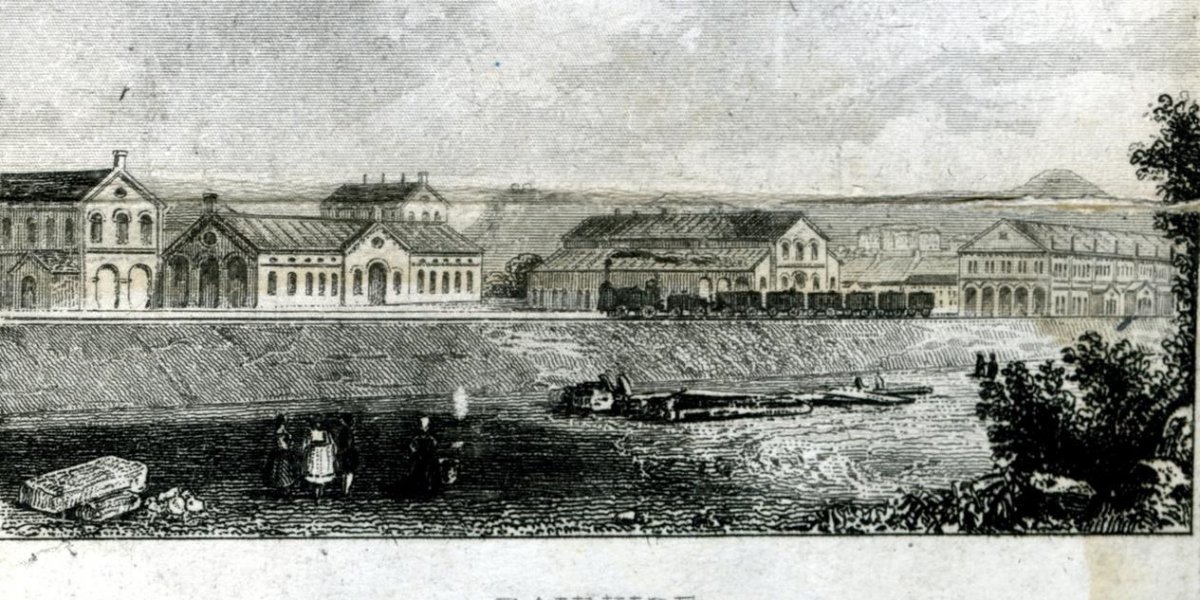The Pest – Vienna railway was a vital development. It was no coincidence that the first (steam-drawn) Hungarian railway line ran to Vác. The first line was built not because Vác was important to Pest during the Reform Period, but because the railway was the first section of a line to Vienna that would run on the left (eastern) bank of the Danube. This line proved to be a central element of transportation policy even in the reform period.

The Pest Train Station, the predecessor to Budapest's Nyugati Railway Station Trains, were slow in 1850, compared to today but still brought a massive leap in transportation (Source: Budapest Szabó Ervin Metropolitan Library, Budapest Collection)
However, in a major debate raged in the first half of the 1840s on which side of the river the railroad should run along. Széchenyi supported György Sina's idea, which would have run along the right bank line. This also seemed logical because Vienna itself is on the right bank of the Danube.
However, a decision in favour of the left-bank-line was reached. The route was supported by the banker Móric Ullmann. A private company created by Ullman, Magyar Középponti Vasút ('Hungarian central railway') began construction in 1844. The first stage was completed to Vác in 1846. A year later, in 1847, the Pest – Szolnok breach was finished. In 1848, the Pozsony (Pressburg, today Bratislava, Slovakia) – Marchegg section to the Austro-Hungarian border, with the first Hungarian rail tunnel was completed.
Construction stopped during the War of Independence, and the Hungarian government took over the company. Later the company also fell victim to the defeat of the War of Independence. Magyar Középponti Vasút went bankrupt in 1849.
The Austrian state acquired the company in March 1850, and the Vienna – Pest railway opened as a state railway. Albeit not one owned by the Hungarian state but by the Austrian Southeastern State Railway.

The banker behind the construction of the first Hungarian steam-powered railway line: Móricz Ullmann (1782–1847) in a painting by Miklós Barabás
Construction of the railway could continue after the defeat of the War of Independence because it was part of a network in Northern Austria and the Czech Republic, which expanded into the Great Plain and served Austrian interests.
The Hungarian press was limited in 1850 and covered the significant event in short reports. On 17 December 1850, Hölgyfutár wrote:
“Many are travelling to Vienna by rail solely due to the novelty of the experience. It is likely that many will visit Budapest from Vienna as well in the coming month."
The following announcement appeared in the Pesti Napló on 14 December 14 1850:
“Announcement. Simultaneously with the opening of the new section of the Szolnok–Vienna railway on the 16th of this month, on which one train runs daily, leaving from Vienna for Szolnok at 7 in the morning, reaching Pest at 6, and arriving in Szolnok at 9; and from Szolnok the leaving at 45 minutes past 5 o'clock in the morning, reaching Budapest at 8:45 and Vienna at 8 in the evening, the following changes in postal service within the country are announced:
1) The post is to travel by rail between: Pest, Vác, Esztergom, Érsek-Újvár, Pozsony (present-day Bratislava, Szlovakia – Trans.) and Vienna.
2) The post carriages running between post offices on the Pest–Vienna line will be abolished. A freight carriage will operate on Thursdays and Sundays, while a letter post service will run at 6 pm in the evening on all other days."
The train was not fast. It reached Vienna from Pest in 11 hours, and Szolnok from Pest in 3 hours.
In Pesttrains arrived in the railway station which opened in 1846. The building stood on the site of the present-day Nyugati Railway Station but reached further south, to Jókai Street.
However, the opening of the Vienna railway line brought a significant change to life in Pest. The new connection made it easier and cheaper for Hungarian crops to reach the market, which boosted trade.

Europe's railways in 1850 (Source: https://commons.princeton.edu/mg/european-railroads-in-1850/)
The opening of the railway line meant much more than a faster connection to Pozsony or Vienna. Pest became a part of the then European railway network which covered 23,500,000 kilometres, and connected Central Europe, with the cities of northern Germany and ran from Paris to Szolnok.
Cover photo: Train depart the train station in Pest (Source: Budapest Szabó Ervin Metropolitan Library, Budapest Collection)









Hozzászólások
Log in or register to comment!
Login Registration